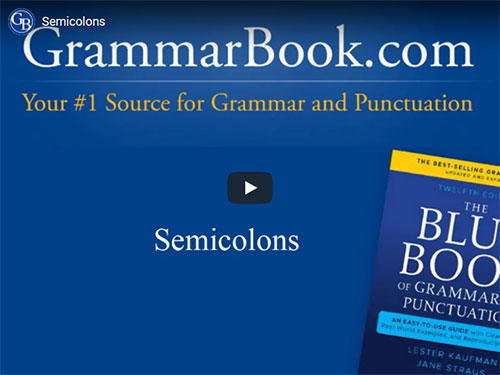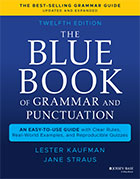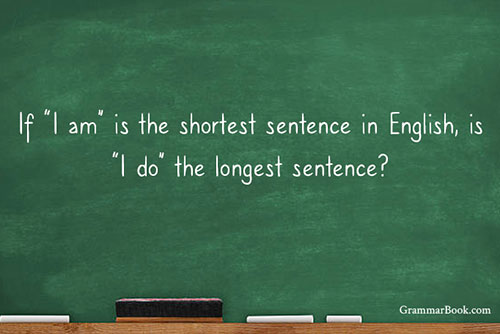|
English provides us with punctuation as a system of symbols and signs that allow us to structure, pace, and clarify communication.
When used correctly, punctuation contributes to succinct and persuasive writing (the word punctuation originates from the Latin punctuare, which means “making a point”). When used incorrectly, it can confuse and even repel our readers.
The colon and semicolon are two marks whose functions can sometimes be misapplied. We'll review primary uses of each one to reinforce accuracy with them in your writing.
Colons
One way to distinguish the colon (:) is to think of it as the mark that introduces something or sets up the idea of “as follows.” In this way, it serves as a type of “equal” sign (what we're saying is leading up to and equaling this: the point we're making right here).
A colon creates a more-emphatic stop or pause than a semicolon does.
Examples
Samesh knew that only one thing could win back Nina's heart: the truth. (The colon introduces what the opening complete sentence will emphasize.)
Walter has visited every major U.S. city but three: Denver, Dallas, and Seattle. (The colon introduces a list.)
Ju-long spoke: “I listened to the voice of the day as it whispered to me at dawn, and it told me my quest must be taken alone.” (The colon introduces and amplifies dialogue.) |
If an independent clause uses a colon to introduce another independent clause, the first word of the second independent clause is capitalized:
| The board of directors understood one thing: The next company CEO would need to be just as friendly and likable as visionary and driven. |
Beyond their function within composition, colons also have nongrammatical uses, such as in time elapsed, time of day, biblical verses, and mathematical equations.
Examples
She finished the marathon in 4:57:23.
It's currently 7:14 p.m.
John 16:33
x:y = 18:6 |
We would not use a colon after an introduction that is not a complete statement.
Incorrect: I like: cars, bikes, trains, and motorcycles.
Incorrect: I have visited: Denver, Dallas, and Seattle. |
Semicolons
The semicolon (;) is used mainly to join separate but related independent sentences that are not linked by a conjunction. In some cases, the second independent sentence may begin with a conjunctive adverb.
A semicolon creates a less-emphatic stop or pause than a colon does.
Examples
Your efforts can reap great rewards; your taxes will be thankful. (The semicolon joins two related independent clauses with a softer separation than a period would provide.)
Joelle wants to be wealthy someday; however, she first must learn to maintain her checking account. (The semicolon joins an independent clause to a related independent clause that begins with a conjunctive adverb to indicate contrast.)
Another main function of the semicolon is to further separate and organize items in a list with multiple internal commas. Consider the following text:
The weekend's amateur golf tournament will include rising contenders such as Roger Bird of Provo, Utah, Andres Gomez of Grosse Pointe, Michigan, Hideki Ishikawa of San Luis Obispo, California, and Paddy O'Malley of Boston, Massachusetts.
Samuel Hatfield, chief security officer, Vijay Kapoor, concessions manager, Sang-Moon Park, director of guest services, and Fredrick Stenson, ticket scanner supervisor, all attended the pre-game meeting. |
Now consider the same content with semicolons included:
The weekend's amateur golf tournament will include rising contenders such as Roger Bird of Provo, Utah; Andres Gomez of Grosse Pointe, Michigan; Hideki Ishikawa of San Luis Obispo, California; and Paddy O'Malley of Boston, Massachusetts.
Samuel Hatfield, chief security officer; Vijay Kapoor, concessions manager; Sang-Moon Park, director of guest services; and Fredrick Stenson, ticket scanner supervisor, all attended the pre-game meeting. |
The semicolons aid clarity in the lists, which otherwise make us focus more on the internal commas to understand what's written.
Colon vs. Semicolon: Closing Thoughts
With a greater awareness of the distinctions between the colon and semicolon, you can also use them both in a passage:
| The following personnel all attended the pre-game meeting: Samuel Hatfield, chief security officer; Vijay Kapoor, concessions manager; Sang-Moon Park, director of guest services; and Fredrick Stenson, ticket scanner supervisor. |
When adding colons and semicolons, be sparing and mindful; less is truly more with these marks. They should serve to guide, clarify, and emphasize only where needed in keeping readers moving through your precise and eloquent writing.
Related Topics
Using Commas, Semicolons, and Colons Within Sentences
Colons
Semicolons
|
View and comment on this
article on our website.
|
|
|

|
Pop Quiz
Punctuate each sentence properly according to what you understand about colons and semicolons.
1. We haven't yet decided if the team flag should be red, white, and blue, black, white, and yellow, or blue, white, and orange.
2. I'll say this much You sure know how to plant a rose garden.
3. It's great that they sold out the show however, they sold more tickets than available seats.
4. There are only three Chevy Chase movies that Jackson hasn't seen Foul Play, Modern Problems, and Oh! Heavenly Dog.
5. Pietro wants to marry Gianna wants to date.
|
 |
The Blue Book of Grammar and Punctuation
by Lester Kaufman and Jane Straus |
The Authority on English Grammar! Twelfth Edition Now Available
An indispensable tool for busy professionals, teachers, students, homeschool families, editors, writers, and proofreaders.
Available in print AND as an e-Book! Over 2,000 copies are purchased every month!
To order the book, simply click the link to order the book from the GrammarBook.com website.
|
Get Even More Useful Grammar Tips
In addition to our weekly newsletter, we post new entries about American English grammar. The following is our most recent article. Bookmark our GrammarBook blog and be sure to check it often.
What Is a Noun Clause?
|
Free BONUS Quiz for You!
[[firstname]], because you are a subscriber to the newsletter, you get access to one of the Subscribers-Only Quizzes. Click here to take a Pronouns Quiz and get your scores and explanations instantly!
We will be adding many more quizzes this year to our already substantial list of them. If you have suggestions for topics we have not yet covered, please send us a message at help@grammarbook.com.
|
Hundreds of Additional Quizzes
at Your Fingertips
Subscribe now to receive hundreds of additional English usage quizzes not found anywhere else!
Teachers and Employers
Save hours of valuable time! You may assign quizzes to your students and employees and have their scores tallied, organized, and reported to you! Let GrammarBook.com take the hassle out of teaching English!
"Fun to test my skills."
"The explanations really help ... thanks!"
"I can select the quizzes to assign to my students, and then the results are reported to me automatically!"
99¢
QUIZZES
|
Don't need all the quizzes?
You can now purchase the same quizzes individually for ONLY 99¢ each.
Purchase yours here.
|
If you think you have found an error in a quiz, please email us at help@grammarbook.com
|
Wordplay

Pop Quiz Answers
1. We haven't yet decided if the team flag should be red, white, and blue; black, white, and yellow; or blue, white, and orange.
2. I'll say this much: You sure know how to plant a rose garden.
3. It's great that they sold out the show; however, they sold more tickets than available seats.
4. There are only three Chevy Chase movies that Jackson hasn't seen: Foul Play, Modern Problems, and Oh! Heavenly Dog.
5. Pietro wants to marry; Gianna wants to date.
|
 |
English In A Snap:
68 One-Minute English Usage Videos FREE |
Learn all about who and whom, affect and effect, subjects and verbs, adjectives and adverbs, commas, semicolons, quotation marks, and much more by just sitting back and enjoying these easy-to-follow lessons. Share them with your colleagues (and boss), children, teachers, and friends as well! Click here to watch.
|
|





